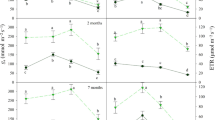Abstract
The effects of simulated herbivory (early or late defoliation and cutting of the flowering shoot) on the growth and reproduction of three species of monocarpic composite forbs (Crepis pulchra, Picris hieracioides and C. foetida) with different inflorescence architectures were studied in experimental plots. For the three species studied, early defoliation had no significant effect on subsequent growth. In contrast, late defoliation, occurring at the start of the season of drought, had a negative effect on growth and reproduction in the two Crepis species, particularly C. foetida, but had less effect on P. hieracioides. Sexual biomass was more clearly affected by late defoliation than was vegetative biomass, although the effects differed markedly among species possibly as a result of differences in phenology. Clipping the flowering shoot removed about 3 times less biomass than late defoliation and had little effect on vegetative biomass. It had much greater effects on the sexual biomass in P. hieracioides and C. pulchra, and resulted in the production of many shoots sprouting from the rosette, allowing the treated plants to regain a vegetative biomass close to that of control plants. Clipping did however lead to the production of shorter shoots and a reduction in the number of capitula formed. In C. foetida, much branching occurred even when the main shoot was not cut; the architecture of individual plants was therefore only slightly changed by clipping the apical bud and the sexual biomass of this species was not affected by ablation of the flowering shoot. Overcompensation was found in only two families of C. pulchra for vegetative biomass. No over-compensation was found for sexual biomass, despite an increase in the number of flowering shoots in C. pulchra and P. hieracioides following clipping. However situations close to compensation for the vegetative biomass in the three species and in P. hieracioides for the sexual biomass were recorded. The response of the three study species to simulated herbivory were related to their architecture and to the time of defoliation.
Similar content being viewed by others
References
Alward RD, Joern A (1993) Plasticity and overcompensation in grass responses to herbivory. Oecologia 95:358–364
Belsky AJ (1986) Does herbivory benefit plants? A review of the evidence. Am Nat 127:870–892
Bergelson J, Crawley MJ (1992) Herbivory and Ipomopsis aggregata—the disadvantages of being eaten. Am Nat 139:870–882
Brown VK, Gange AC (1990) Insect herbivory belowground Adv Ecol Res 20:1–58
Brown VK, Gange AC (1992) Secondary plant succession — how is it modified by insect herbivory. Vegetatio 101:3–13
Chapin FS, Bloom AJ, Field CB, Waring RH (1987) Plant responses to multiple environmental factors. Bioscience 37:49–57
Connell JH (1978) Diversity in tropical rainforests and coral reefs. Science 1999:1302–1310
Coste H (1937) Flore descriptive et illustrée de la France, de la Corse et des contrées limitrophes. Librairie des Sciences, Paris
Day RW, Quinn GP (1989) Comparisons of treatments after an analysis of variance in ecology. Ecol Monogr 59:433–463
Doak DF (1992) Lifetime impacts of herbivory for a perennial plant. Ecology 73:2086–2099
Dyer MI, Turner CL, Seastedt TR (1993) Herbivory and its consequences. Ecol Appl 3:10–16
Gedge KE, Maun MA (1992) Effects of simulated herbivory on growth and reproduction of 2 beach annuals, Cakile edentula and Corispermum hyssopifolium. Can J Bot 70:2467–2475
Hendrix SD (1988) Herbivory and its impact on plant reproduction. In: Lovett Doust J, Lovett Doust L. (eds) Plant reproductive ecology. Patterns and strategies. Oxford University Press, Oxford, pp 246–263
Hjalten J, Danell K, Ericson L (1993) Effects of simulated herbivory and intraspecific competition on the compensatory ability of birches. Ecology 74:1136–1142
Huntly N (1991) Herbivores and the dynamics of communities and ecosystems. Annu Rev Ecol Syst 22:477–503
Jameson DA (1963) Response of individual plants to harvesting. Bot Rev 29:532–594
Lubbers AE, Lechowicz MJ (1989) Effects of leaf removal on reproduction vs. belowground storage in Trillium grandiflorum. Ecology 70:85–96
Marquis RJ (1984) Leaf herbivores decrease fitness of a tropical plant. Science 226:537–539
Maschinski J, Whitham TG (1989) The continuum of plant responses to herbivory: the influence of plant association, nutrient availability, and timing. Am Nat 134:1–19
Mauricio R, Bowers MD, Bazzaz FA (1993) Pattern of leaf damage affects fitness of the annual plant Raphanus sativus, Brasicaceae. Ecology 74:2066–2071
McNaughton SJ (1983) Compensatory plant growth as a response to herbivory. Oikos 40:329–336
McNaughton SJ (1986) On plants and herbivores. Am Nat 128: 765–770
Michaud JP (1991) Biomass allocation in fireweed Epilobium angustifolium L. (Onagraceae) in response to simulated defoliation. Bot Gaz 152:208–213
Obeso JR (1993) Does defoliation affect reproductive output in herbaceous perennials and woody plants in different ways? Funct Ecol 7:150–155
Paige KN (1994) Herbivory and Ipomopsis aggregata: differences in responses, differences in experimental protocol: a reply to Bergelson and Crawley. Am Nat 143:739–749
Paige KN, Whitham TG (1987) Overcompensation in response to mammaliant herbivory: the advantage of being eaten. Am Nat 129:407–416
Painter EL, Belsky AJ (1993) Application of herbivore optimization theory to rangelands of the western United States. Eco Appl 3:2–9
Painter EL, Detling JK (1981) Effects of defoliation on net photosynthesis and regrowth of western wheatgrass. J Range Manage 34:67–71
Rockwood IL (1973) The effect of defoliation on seed production of six costarican tree species. Ecology 54:1363–1369
SAS (1989) SAS/STAT user's guide, release 6.03 Ed, SAS Institute Inc, Cary
Sentuc JJ (1993) Effects des invertébrées herbivores dans les successions post-culturales méditerranéennes (D.E.A. évolution et écologie) U.S.T.L., Montpellier
Zar JH (1984) Biostatistical analysis, 2nd edn. Prentice-Hall, Englewood Cliffs
Zellner ID, Clauss MJ, Hik DS, Jefferies RL (1993) Growth responses of artic graminoids following grazing by captive lesser snow geese. Oecologia 93:487–492
Author information
Authors and Affiliations
Corresponding author
Rights and permissions
About this article
Cite this article
Escarré, J., Lepart, J. & Sentuc, J.J. Effects of simulated herbivory in three old field Compositae with different inflorescence architectures. Oecologia 105, 501–508 (1996). https://doi.org/10.1007/BF00330013
Received:
Accepted:
Issue Date:
DOI: https://doi.org/10.1007/BF00330013




